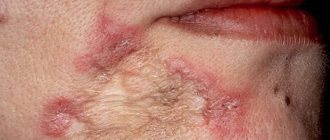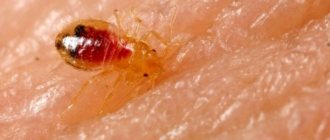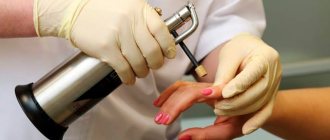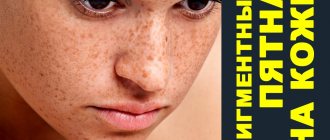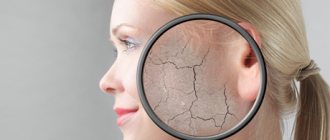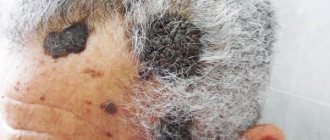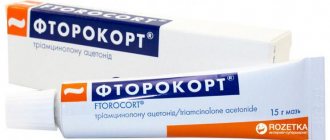Skin tuberculosis: types of disease
Infection by tuberculosis microorganisms has more than one classification. The most common “division” of the types of this disease is the division into focal tuberculosis, or otherwise localized, and widespread tuberculosis, otherwise disseminated. Let's look at each type separately and consider the subspecies. Localized tuberculosis can occur in the following forms:
- Lupus vulgaris (ordinary): one of the most common forms, which most often occurs at a very early age. Skin rashes in this form are localized mainly on the face; in advanced stages, “bumps” may appear in the mouth and on the nasal mucosa. Lupus vulgaris inflammations are located deep under the skin and are yellow-pink in color. However, such spots have clearly visible boundaries. As the disease progresses, these bumps become more and more noticeable, but do not emerge from under the skin.
- Scrofuloderma (colliquative tuberculosis): after lupus vulgaris, this form ranks 2nd in frequency of distribution. This form is characterized by the development of nodules reaching a diameter of 4-5 mm. The nodules are deep, but practically do not cause pain. You can notice them by the blue tint on the skin. As the disease progresses, the nodules can turn into an abscess, which, when opened, may leave an ulcer. As a rule, the reasons for the appearance of this form are called infection from the affected lymph nodes, or from other tissues. This form usually “chooses” the neck or limbs as its location.
- Ulcerative cutaneous tuberculosis: can develop due to infection from various affected tissues and organs. It is characterized by numerous bleeding ulcers on the skin that have yellowish nodules. Such nodules appear, most often, on the mucous membranes and skin surrounding it (genitals, mouth).
- Warty cutaneous tuberculosis: one of the most dangerous and complex types. It is characterized by the appearance of blue-red infiltrates (a kind of compaction, accumulation in a certain place of the body of cellular elements mixed with lymph or blood), which subsequently develop into warts. The causes are external stimuli. This form of skin tuberculosis is called “occupational”, since professions such as veterinarians, pathologists and others are most often at risk of infection. The location is the back of the hand and fingers.
Focal tuberculosis has been dealt with. What about the second type? Disseminated tuberculosis includes the following forms:
- Papulonecrotizing cutaneous tuberculosis: a form that most often appears at a young age. It is characterized by the development of blue-red seals, in the middle of which there are scabs, that is, a crust covering the seal. As a rule, such rashes are located on the buttocks or limbs. It is worth noting that after the scab falls off, a characteristic scar remains on the skin.
- Lichenoid cutaneous tuberculosis: or in other words, the well-known scrofulous lichen. Common rashes that affect the skin of the body.
As you can see, the difference between the two types of skin tuberculosis lies in the extent of the infection . Now we need to figure out the reasons for the appearance.
Causes
Most often, cutaneous tuberculosis is diagnosed in those who have previously been infected with Koch's bacillus, the causative agent of all forms of tuberculosis, or are at the stage of fighting the disease.
But it happens that the human body is infected with mycobacteria for the first time. In such cases it is called primary.
Healthy skin is an unfavorable environment for tuberculosis mycobacteria. Its protective properties can repel Koch's bacillus even when tuberculosis has affected other organs.
However, it should be remembered that there are a number of factors that significantly increase the likelihood of developing the disease.
Skin tuberculosis: causes and development
Despite all the types, it has been revealed that skin tuberculosis is one of the rarest forms of the disease . It is believed that the most “favorable” organs for the development of Koch’s bacillus are the lungs, while the skin has a strong protective layer of the epidermis.
The cause of the development of skin tuberculosis is the occurrence of infection against the background of damage to internal organs. In this case, the infection “reaches” the skin through blood and lymph . The disease can also be contracted through external influences. For example, in case of injury to the skin and in direct interaction with the source of infection (a contaminated object, contaminated substances or with a person who already has tuberculosis).
I would like to note that the skin actually has a persistent protective property and the development of cutaneous tuberculosis infection requires the presence of additional factors . These factors include the following:
- unhealthy diet, as well as its uniformity;
- unfavorable environment: poor environmental condition in the area of residence, non-compliance with sanitary standards at home, in living quarters;
- work in hazardous industries: the chemical industry is especially worth highlighting;
- lack of sun: a small amount of sunlight in a person’s life has a negative effect on the skin and the general condition of the body, as there is a “lack of vitamin D”;
- low level of everyday culture in residential premises;
- antisocial lifestyle: neglect of sanitary standards, neglect of contraception.
It can be noted that all factors are certain daily problems associated with limitations in funds, time, fatigue or the person’s reluctance to comply with something. All these aspects, at a certain level of life in a country, can simply disappear or, if implemented properly, turn into a habit of life for every person.
Diagnostics
If you experience any symptoms of cutaneous tuberculosis, you should consult a doctor who will prescribe you the following procedures:
- Mantoux test.
- Chest X-ray.
- Pirquet's test, which detects cutaneous forms of tuberculosis.
It is important to understand that tuberculosis is a complex disease that requires careful diagnosis. Therefore, performing only the Mantoux test in this case is not appropriate. Often, discharge from wounds and ulcers is also taken for analysis.
Skin tuberculosis: symptoms
Skin tuberculosis, according to the degree of its development, can manifest itself in only two forms: weeping and dry. Consequently, symptoms are divided according to the same criterion.
Dry form
- peculiar blisters appear, after rupture of which the skin can recover;
- After such a rupture, scars appear on the skin, characterized by dry, thin and white skin. The skin is very thin and cannot be softened by any creams. Very often, a new focus of the disease may appear on top of such skin.
Wetting form
- rashes appear that appear as “tubercles”, unlike pimples, have a color closer to brown and do not have a purulent core in their “structure”. Over time, such “tubercles” become covered with scales and crusts, and subsequently grow together into common nodes. They are resistant to antibiotics;
- The skin with the development of “tubercles” is more and more prone to rejection. The “tubercles” are filled with blood and lymph. This mixture, and most often the lymph, is the same infectious substance as the sputum discharge from pulmonary tuberculosis;
- if the “tubercle” is torn off late, an ulcer may remain on the skin.
If skin tuberculosis is detected in a timely manner, treatment will consist of only a few courses of certain medications . It is very important not to neglect this disease, since most often it is skin tuberculosis that affects the upper part of the body and damage to not only the upper tissues, but also the internal ones, namely the brain tissues, will be very dangerous.
Treatment
Treatment of tuberculosis of the skin and subcutaneous tissue is conservative. The main aspect of therapy is the use of medications that are effective against mycobacteria. The main goals of therapy are:
- treatment of the underlying disease (miliary, focal or disseminated forms of pulmonary tuberculosis);
- elimination of the source of infection in the skin;
- increasing immunity;
- prevention of complications;
- improvement of skin condition.
Which doctor should I contact?
If you suspect tuberculosis, you should consult a dermatologist. You may need to consult a therapist, phthisiatrician and infectious disease specialist.
Traditional therapy
Clinical treatment recommendations include:
- Use of systemic anti-tuberculosis drugs.
- Quitting bad habits (cigarettes, alcohol, drugs).
- Physiotherapy (electrophoresis and ultraviolet irradiation).
- Improving living conditions.
- Boosting immunity. Achieved through maintaining an active lifestyle and playing sports.
- Complete nutrition. Patients need to eat fresh vegetables, fruits and herbs every day. The menu should contain sources of complete protein (natural lean meat, eggs, fish, seafood, milk and dairy products).
- The use of traditional medicine.
If the skin is damaged by mycobacteria, the following drugs can be prescribed:
- Streptomycin-KMP. Available in powder form for solution (administered intramuscularly). Belongs to the aminoglycoside group of antibiotics. It is bactericidal (kills bacteria). The mechanism of action is associated with disruption of protein synthesis of microbial cells. Streptomycin is contraindicated in cases of intolerance, endarteritis, muscle weakness, damage to the 8th pair of cranial nerves, severe renal and heart failure, cerebral circulation disorders, during lactation and pregnancy.
- Rifampicin and its analogues (Farbutin, Makoks, Rimpin, Eremfat). The active ingredient is rifampicin. Rifampin is used in the form of lyophilisate and capsules for oral administration. This is a 1st line drug. Rifampicin is bactericidal. Contraindicated in cases of jaundice, recent liver inflammation, hypersensitivity and kidney dysfunction.
- Isoniazid. 1st line drug, produced in the form of tablets and solution for injection. Contraindicated for convulsions, intolerance, poliomyelitis, epilepsy, atherosclerosis, kidney and liver dysfunction.
- Ethambutol-Acri and its analogues (Ethambusin, Ekoks, EMB-Fatol 400). They have a bacteriostatic effect by disrupting RNA synthesis. Ethambutol is not prescribed for intolerance, gout, diabetic retinopathy, optic neuritis, cataracts, severe renal failure, inflammation of the eye structures, children under 13 years of age, pregnant and lactating women.
- Iso-Eremphat. A combination drug containing rifampicin and isoniazid. Used in the initial stages of tuberculosis.
- Forkoks. Contains 4 antibiotics: ethambutol, isoniazid, rifampicin and pyrazinamide.
- Phthisoetam.
- Pyrazinamide-NIKKa. Its analogue is Pisina. The active substance is pyrazinamide. It has a bacteriostatic and bactericidal effect (determined by the concentration in the blood). This is a second-line anti-tuberculosis drug for oral administration. The medicine is contraindicated in case of intolerance and liver dysfunction. A side effect is a violation of the excretion of uric acid from the body and an increase in the concentration of sugar in the blood (hyperglycemia).
- Kanamycin.
- Phtivazid.
- Prothionamide (Protomid, Petecha).
Treatment of tuberculosis is long-term (6-8 months). 4-5 medications can be prescribed at the same time. In case of intolerance or ineffectiveness of the 1st line drug, 2nd line agents are used. The criteria for recovery are negative results for Mycobacterium tuberculosis and the disappearance of complaints.
Traditional methods of treatment
The following can be used simultaneously with antibiotics:
- Aloe juice. Used as lotions and compresses.
- A mixture based on fresh marshmallow root and sour cream.
- Ointment based on celandine powder, petroleum jelly and lanolin.
- A decoction of burdock root with the addition of golden mustache. To prepare it you will need 50 g of the plant, 7 tsp. golden mustache juice and 1 liter of boiling water.
- An infusion based on nettle and boiling water. Can be used internally and externally.
Skin tuberculosis - photo
Symptoms of skin tuberculosis
Classification
The following classification of tuberculosis of the skin and subcutaneous fat is used:
- Localized forms:
1. Tuberculous chancre.
2. Tuberculous lupus.
3. Warty skin tuberculosis.
4. Coliquatic tuberculosis of the skin.
5. Ulcerative tuberculosis of the skin and mucous membranes.
6. Beck's sarcoid.
- Disseminated forms:
1. Acute miliary tuberculosis of the skin.
2. Lichenoid tuberculosis of the skin.
3. Miliary disseminated lupus.
4. Papulo-necrotic tuberculosis of the skin.
5. Erythema induratum of Bazin.
Prevention
- Improving living conditions
- Taking general strengthening agents: vitamins, ascorbic acid, calcium, fish oil, iron supplements, thiamine
- Varied and nutritious foods
- Constant exposure to fresh air
- Prevention in specialized sanatoriums
- State control in the form of mandatory fluorography makes it possible to detect the disease in the early stages and prescribe timely treatment
Anti-inflammatory dermatotropic drug. Application: acne. Price from 200 rub. Analogs: Differin, Alaklin, Adolen. You can find out more about analogues, their prices, and whether they are substitutes at the end of this article. Today we’ll talk about Adapalene cream. What is this product and how does it affect the body? What are the indications and contraindications? How and in what doses is it used? […]
Antibacterial drug. Application: wounds, burns, ulcers, conjunctivitis. Price from 27 rub.
Regenerative medicine. Application: wounds, burns, bedsores, ulcers. Price from 111 rub.
Natural emollient hygienic medicine. Application: dry skin, cracked nipples, dermatitis. Price from 612 rub. Analogues:
Non-hormonal antiseptic antimicrobial drug.
Non-hormonal angioprotective decongestant drug.
For the average person, tuberculosis of the lungs or bones is familiar concepts, but not everyone knows what tuberculosis of the skin is. This disease is not so dangerous in social terms, although it occurs in all countries, regardless of the standard of living of the population.
Skin tuberculosis is a general name for skin pathologies caused by colonies of the tuberculosis pathogen colonized in the skin and subcutaneous tissue.
